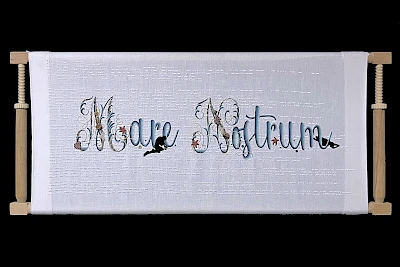Mare Nostrum
| Year: | 2025 |
| City: | Lampedusa, Italy |
| Measures: | 98 × 44,5 cm |
| Media: | Hand embroidery on linen, cotton thread |
| Exhibitions: | |
| Projects: |
What does it mean when a sea once called “ours” becomes a grave? In “Mare Nostrum,” Tanja Boukal weaves together beauty and tragedy—stitch by stitch—into a haunting textile memorial that commemorates one of the most devastating and politically revealing shipwrecks in recent European history.
On October 11, 2013, an overcrowded refugee boat carrying around 400 people sank between Malta and Lampedusa. Most passengers were from Syria, including many families with children. For hours, they pleaded for help via satellite phone, but responsibility for the rescue was disputed between the Italian and Maltese coast guards. The original radio exchange is chilling:
“People are dying, please. They need help. [...] The boat is going down now!”
– “We know, but the boat is in Maltese waters.”
– “But Malta says it’s your area. You must come!”
– “We cannot do anything. Call Malta.”
Rescue arrived four hours later—too late for many. According to the International Organization for Migration (IOM), at least 268 people died, including 60 children.
Tanja Boukal has fully transcribed this distress call onto linen using Morse code, a long-obsolete form of communication that here becomes a symbol of bureaucratic inertia and collective failure. The dense rows of stitched dots and dashes resemble a cryptic carpet of distress signals—a silent disturbance stitched into the surface.
In front of this background, the phrase “Mare Nostrum” appears, rendered in cheerful shades of blue and turquoise inspired by the decorative aesthetic seen in souvenirs and signage around Lampedusa—shells, wave motifs, vibrant seaside colors. Yet upon closer inspection, the idyll is ruptured: integrated into the lettering are two realistically embroidered human figures—one mourning, one lifeless. Death is literally woven into the name.
The title Mare Nostrum refers to the Italian naval rescue operation launched in response to the shipwrecks of 2013. Within one year, it rescued over 130,000 people from the Mediterranean. But the mission was soon abandoned for cost reasons. It was replaced by smaller, border-focused operations. Today, thousands continue to die on the Central Mediterranean route: In 2023 alone, the IOM recorded at least 2,498 deaths, making it the deadliest migration route in the world. The political promises of "Never again" quickly faded.
With Mare Nostrum, Tanja Boukal creates a quiet yet powerful memorial. Her labor-intensive hand embroidery—executed by the artist herself—merges traditional textile craft with political documentation. Embroidery, a medium historically associated with femininity and domesticity, becomes here an act of resistance and remembrance. Mare Nostrum is a textile monument to Europe’s selective memory—a call to look more closely where we are used to looking away.
Mare Nostrum is part of HOSPITIUM – The Lampedusa Project, a year-long art initiative by Tanja Boukal, developed within the framework of Agrigento Capitale della Cultura 2025.
A video documenting the original emergency call
We need your consent
We would like to embed the following video from YouTube:
https://youtu.be/XOuRvdwHDFU?si=FDHDzWEJvpuFHqb5
By allowing to embed the video, you agree to our Privacy Policy.





